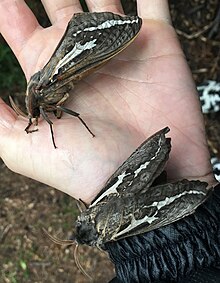| Abantiades atripalpis | |
|---|---|

| |
|
Scientific classification
| |
| Domain: | Eukaryota |
| Kingdom: | Animalia |
| Phylum: | Arthropoda |
| Class: | Insecta |
| Order: | Lepidoptera |
| Family: | Hepialidae |
| Genus: | Abantiades |
| Species: | A. atripalpis
|
| Binomial name | |
| Abantiades atripalpis (
Walker, 1856)
| |
| Synonyms | |
| |

Abantiades atripalpis, also known as bardee (bardy, bardi) grub, rain moth or waikerie, and previously known as Trictena atripalpis, [1] is a moth of the family Hepialidae. It is found in the whole southern half of Australia.
Habitat
The rain moth is found right across southern Australia in woodland areas alongside creeks and gullies, especially near eucalyptus trees. [2]
Larvae
The caterpillar is used extensively by fishermen as bait. [2] This is where the common name "bardee", "bardi", "badee", or "bargi grub" is derived from. This name is also used for the larva of the beetle Bardistus cibarius (Cerambycidae), as well as various ground dwelling and wood boring moth larvae. [3]
The larvae live in tunnels, [2] feeding on Casuarina pauper and Eucalyptus species, especially Eucalyptus camaldulensis. [3] They are herbivores. [2]
Moth
The other common name, "rain moth", stems from the fact that adults often emerge after rain, typically in autumn, [4] leaving the empty pupal cases sticking up out of the ground.
The wingspan is up to 120 millimetres (4.7 in) for males and 170 millimetres (6.7 in) for females. The moths have fawn coloured wings with two silver flash markings across each fore wing. [3] They can be the same size as a small insectivorous bat, and owls often prey on them. [2] The body reaches a length of 120 mm. [5]
The adult females produce a great number (up to 40,000) of eggs, which are scattered while flying. Their flight months are in Autumn (April to June). [4]
References
- ^ Herbison-Evans, Don; Crossley, Stella. "Abantiades atripalpis". Australian Butterflies and their Caterpillars. Archived from the original on 22 April 2023. Retrieved 22 April 2023.
- ^
a
b
c
d
e NRM Education (Adelaide and Mount Lofty Ranges Natural Resources Management Board). Natural Resources, Adelaide and Mount Lofty Ranges: Creature features2013 – 2019. Government of South Australia.
Licensed under Creative Commons Attribution 3.0 Australia License
- ^ a b c Don Herbison-Evans & Stella Crossley (26 May 2008). "Trictena atripalpis". uts.edu.au. Archived from the original on 24 September 2009. Retrieved 11 February 2009.
- ^ a b Jennings, J.T., Austin, A.D., Davies, K., Harvey, M., Hirst, D. & Taylor, G. 2009, Terrestrial Invertebrates. In: Jennings, J.T. (Ed.) Natural History of the Riverland and Murraylands. (Royal Society of South Australia Inc.), pp. 306-333.
- ^ "Sanctuary Lakes Resort - the Rain Moth". Archived from the original on 23 March 2021. Retrieved 1 May 2021.
| Abantiades atripalpis | |
|---|---|

| |
|
Scientific classification
| |
| Domain: | Eukaryota |
| Kingdom: | Animalia |
| Phylum: | Arthropoda |
| Class: | Insecta |
| Order: | Lepidoptera |
| Family: | Hepialidae |
| Genus: | Abantiades |
| Species: | A. atripalpis
|
| Binomial name | |
| Abantiades atripalpis (
Walker, 1856)
| |
| Synonyms | |
| |

Abantiades atripalpis, also known as bardee (bardy, bardi) grub, rain moth or waikerie, and previously known as Trictena atripalpis, [1] is a moth of the family Hepialidae. It is found in the whole southern half of Australia.
Habitat
The rain moth is found right across southern Australia in woodland areas alongside creeks and gullies, especially near eucalyptus trees. [2]
Larvae
The caterpillar is used extensively by fishermen as bait. [2] This is where the common name "bardee", "bardi", "badee", or "bargi grub" is derived from. This name is also used for the larva of the beetle Bardistus cibarius (Cerambycidae), as well as various ground dwelling and wood boring moth larvae. [3]
The larvae live in tunnels, [2] feeding on Casuarina pauper and Eucalyptus species, especially Eucalyptus camaldulensis. [3] They are herbivores. [2]
Moth
The other common name, "rain moth", stems from the fact that adults often emerge after rain, typically in autumn, [4] leaving the empty pupal cases sticking up out of the ground.
The wingspan is up to 120 millimetres (4.7 in) for males and 170 millimetres (6.7 in) for females. The moths have fawn coloured wings with two silver flash markings across each fore wing. [3] They can be the same size as a small insectivorous bat, and owls often prey on them. [2] The body reaches a length of 120 mm. [5]
The adult females produce a great number (up to 40,000) of eggs, which are scattered while flying. Their flight months are in Autumn (April to June). [4]
References
- ^ Herbison-Evans, Don; Crossley, Stella. "Abantiades atripalpis". Australian Butterflies and their Caterpillars. Archived from the original on 22 April 2023. Retrieved 22 April 2023.
- ^
a
b
c
d
e NRM Education (Adelaide and Mount Lofty Ranges Natural Resources Management Board). Natural Resources, Adelaide and Mount Lofty Ranges: Creature features2013 – 2019. Government of South Australia.
Licensed under Creative Commons Attribution 3.0 Australia License
- ^ a b c Don Herbison-Evans & Stella Crossley (26 May 2008). "Trictena atripalpis". uts.edu.au. Archived from the original on 24 September 2009. Retrieved 11 February 2009.
- ^ a b Jennings, J.T., Austin, A.D., Davies, K., Harvey, M., Hirst, D. & Taylor, G. 2009, Terrestrial Invertebrates. In: Jennings, J.T. (Ed.) Natural History of the Riverland and Murraylands. (Royal Society of South Australia Inc.), pp. 306-333.
- ^ "Sanctuary Lakes Resort - the Rain Moth". Archived from the original on 23 March 2021. Retrieved 1 May 2021.